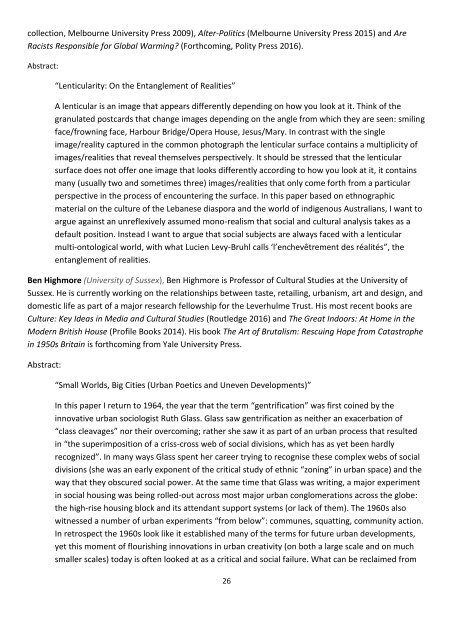Crossroads in Cultural Studies Conference 14-17th December 2016 Program Index
Crossroads-2016-final-draft-program-30-Nov
Crossroads-2016-final-draft-program-30-Nov
You also want an ePaper? Increase the reach of your titles
YUMPU automatically turns print PDFs into web optimized ePapers that Google loves.
collection, Melbourne University Press 2009), Alter-Politics (Melbourne University Press 2015) and Are<br />
Racists Responsible for Global Warm<strong>in</strong>g? (Forthcom<strong>in</strong>g, Polity Press <strong>2016</strong>).<br />
Abstract:<br />
“Lenticularity: On the Entanglement of Realities”<br />
A lenticular is an image that appears differently depend<strong>in</strong>g on how you look at it. Th<strong>in</strong>k of the<br />
granulated postcards that change images depend<strong>in</strong>g on the angle from which they are seen: smil<strong>in</strong>g<br />
face/frown<strong>in</strong>g face, Harbour Bridge/Opera House, Jesus/Mary. In contrast with the s<strong>in</strong>gle<br />
image/reality captured <strong>in</strong> the common photograph the lenticular surface conta<strong>in</strong>s a multiplicity of<br />
images/realities that reveal themselves perspectively. It should be stressed that the lenticular<br />
surface does not offer one image that looks differently accord<strong>in</strong>g to how you look at it, it conta<strong>in</strong>s<br />
many (usually two and sometimes three) images/realities that only come forth from a particular<br />
perspective <strong>in</strong> the process of encounter<strong>in</strong>g the surface. In this paper based on ethnographic<br />
material on the culture of the Lebanese diaspora and the world of <strong>in</strong>digenous Australians, I want to<br />
argue aga<strong>in</strong>st an unreflexively assumed mono-realism that social and cultural analysis takes as a<br />
default position. Instead I want to argue that social subjects are always faced with a lenticular<br />
multi-ontological world, with what Lucien Levy-Bruhl calls ‘l’enchevêtrement des réalités”, the<br />
entanglement of realities.<br />
Ben Highmore (University of Sussex), Ben Highmore is Professor of <strong>Cultural</strong> <strong>Studies</strong> at the University of<br />
Sussex. He is currently work<strong>in</strong>g on the relationships between taste, retail<strong>in</strong>g, urbanism, art and design, and<br />
domestic life as part of a major research fellowship for the Leverhulme Trust. His most recent books are<br />
Culture: Key Ideas <strong>in</strong> Media and <strong>Cultural</strong> <strong>Studies</strong> (Routledge <strong>2016</strong>) and The Great Indoors: At Home <strong>in</strong> the<br />
Modern British House (Profile Books 20<strong>14</strong>). His book The Art of Brutalism: Rescu<strong>in</strong>g Hope from Catastrophe<br />
<strong>in</strong> 1950s Brita<strong>in</strong> is forthcom<strong>in</strong>g from Yale University Press.<br />
Abstract:<br />
“Small Worlds, Big Cities (Urban Poetics and Uneven Developments)”<br />
In this paper I return to 1964, the year that the term “gentrification” was first co<strong>in</strong>ed by the<br />
<strong>in</strong>novative urban sociologist Ruth Glass. Glass saw gentrification as neither an exacerbation of<br />
“class cleavages” nor their overcom<strong>in</strong>g; rather she saw it as part of an urban process that resulted<br />
<strong>in</strong> “the superimposition of a criss-cross web of social divisions, which has as yet been hardly<br />
recognized”. In many ways Glass spent her career try<strong>in</strong>g to recognise these complex webs of social<br />
divisions (she was an early exponent of the critical study of ethnic “zon<strong>in</strong>g” <strong>in</strong> urban space) and the<br />
way that they obscured social power. At the same time that Glass was writ<strong>in</strong>g, a major experiment<br />
<strong>in</strong> social hous<strong>in</strong>g was be<strong>in</strong>g rolled-out across most major urban conglomerations across the globe:<br />
the high-rise hous<strong>in</strong>g block and its attendant support systems (or lack of them). The 1960s also<br />
witnessed a number of urban experiments “from below”: communes, squatt<strong>in</strong>g, community action.<br />
In retrospect the 1960s look like it established many of the terms for future urban developments,<br />
yet this moment of flourish<strong>in</strong>g <strong>in</strong>novations <strong>in</strong> urban creativity (on both a large scale and on much<br />
smaller scales) today is often looked at as a critical and social failure. What can be reclaimed from<br />
26


